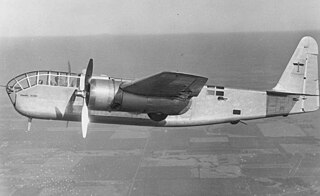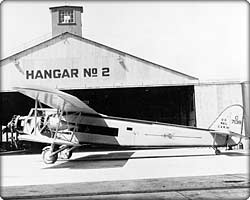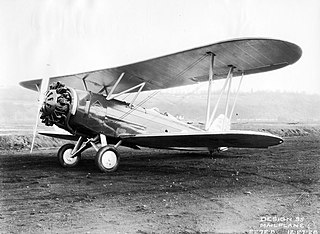Related Research Articles

The Boeing XB-15 was a United States bomber aircraft designed in 1934 as a test for the United States Army Air Corps (USAAC) to see if it would be possible to build a heavy bomber with a 5,000 mi (8,000 km) range. For a year beginning in mid-1935 it was designated the XBLR-1. When it first flew in 1937, it was the most massive and voluminous airplane ever built in the US. It set a number of load-to-altitude records for land-based aircraft, including carrying a 31,205 lb (14,154 kg) payload to 8,200 ft (2,500 m) on 30 July 1939.

The Northrop C-19 Alpha was a series of three aircraft purchased from Northrop by the US Army Air Corps in 1931. They were slightly modified versions of the civil Northrop Alpha Type 2.

The Boeing YB-9 was the first all-metal monoplane bomber aircraft designed for the United States Army Air Corps. The YB-9 was a much enlarged twin-engine development of Boeing's single-engine Model 200 Monomail commercial transport.

The Stearman XA-21 was a competitor in a United States Army Air Corps competition for a twin-engined attack aircraft which led to the Douglas A-20 Havoc, Martin A-22 Maryland and North American B-25 Mitchell.

Boeing XB-55 was a proposed Boeing aircraft designed to be a strategic bomber. The XB-55 was intended to be a replacement for the Boeing B-47 Stratojet in United States Air Force (USAF) service.

The Boeing Model 40 was a United States mail plane of the 1920s. It was a single-engined biplane that was widely used for airmail services in the United States in the 1920s and 1930s, especially by airlines that later became part of United Airlines. It became the first aircraft built by the Boeing company to carry passengers.

The Boeing 80 was an American airliner of the 1920s. A three-engined biplane, the Model 80 was built by the Boeing Airplane Company for Boeing's own airline, Boeing Air Transport, successfully carrying both airmail and passengers on scheduled services.

The Boeing B-1 was a small biplane flying boat designed by William Boeing shortly after World War I.

The Boeing Model 95 was a single engine biplane mailplane built by Boeing in the United States in the late 1920s to supplement the Boeing Model 40s being used on Boeing's airmail routes.
The Bowers Namu II was a single-engine, two-seat, recreational aircraft, designed and flown in the United States in the late 1970s and marketed for homebuilding. It was designed by famed aircraft designer and Boeing historian Peter Bowers.
The Boeing Model 8, a.k.a. BB-L6, was an American biplane aircraft designed by Boeing specifically for their test pilot, Herb Munter.

The Boeing L-15 Scout or YL-15 was a small, piston engine liaison aircraft built by Boeing in very small numbers after World War II. It was a short take-off and landing (STOL) aircraft powered by a 125 hp Lycoming engine. The L-15 was an attempt by Boeing to expand its product line as World War II drew to a close, and Boeing's production of combat aircraft declined. Boeing decided against marketing the L-15 as a general aviation aircraft, and the twelve that were produced went to the United States Army for testing, then were transferred to the United States Fish and Wildlife Service in Alaska for various duties.
The Boeing Model 203 was a three-seat biplane trainer build by Boeing in the late 1920s and used in the company training school.

The Boeing Model 6D, a.k.a. Boeing Model 6E, Boeing B-1D and Boeing B-1E, was an American pusher biplane flying-boat built by Boeing between 1928 and 1929.
The Boeing Model 42 was an American biplane aircraft developed from the Airco DH.4, taking advantage of the large number of aircraft left over after the end of World War I.

The Boeing Model 204 was an American biplane, pusher configuration flying-boat aircraft built by Boeing in 1929. Externally, the 204 looked identical to the Boeing Model 6E, but a number of internal changes, including increasing the passenger capacity to four, gave it a new type certificate and model number.

The Boeing Model 81 was an American training aircraft built by Boeing in 1928. The Model 81 was a development of the Model 64. It was powered by a newly developed engine, the 125 hp Fairchild-Caminez 4-cylinder radial engine. Operating at a much lower rpm than most engines it required the use of a large high-pitch propeller.

The Boeing XPB was an American twin-engined biplane long-range patrol flying boat of the 1920s. A single example was built for the United States Navy.

The Curtiss CA-1 was an American five-seat biplane amphibian designed by Frank Courtney and built by Curtiss-Wright at St Louis, Missouri.
The Boeing XP3B-1 was a proposed patrol aircraft, developed by Boeing for use by the United States Navy in the late 1940s. It was planned to be powered by two Allison T40 turboprops driving contra-rotating propellers, and utilized tandem landing gear. The project was cancelled before any aircraft were built.
References
- ↑ Bowers 1989, p. 51.
- Bowers, Peter M. (1989). Boeing Aircraft Since 1916 . Annapolis, Md.: Naval Institute Press. ISBN 0-87021-037-8. OCLC 20850972.
{{cite book}}: CS1 maint: date and year (link)